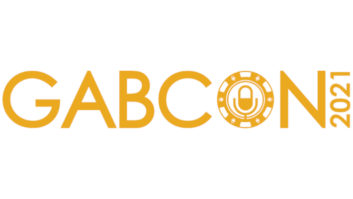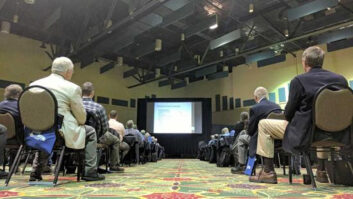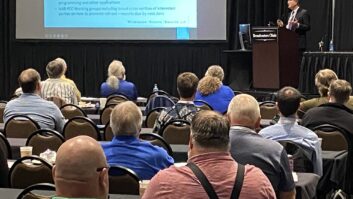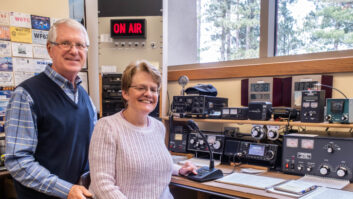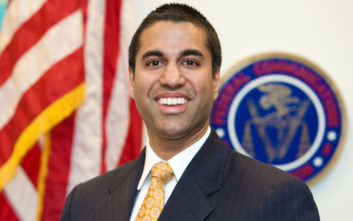 “Being a broadcaster means something different than just being a media company. It means something more.”
“Being a broadcaster means something different than just being a media company. It means something more.”
That’s the country’s top telecom regulator, reminding broadcasters not to lose what makes them unique. FCC Chairman Ajit Pai addressed the NAB Show in Las Vegas Tuesday.
Pai often has referred to his affinity for broadcasting; he did so again in his speech, celebrating personal connections as the greatest competitive edge that TV and radio stations enjoy. “And I say that as someone who still reveres the broadcasters he grew up with — people like Dowe Quick of KOAM(TV) in Joplin, Missouri and Steve Lardy of KLKC(AM) in Parsons, Kansas.”
[Read: FCC Will Try to Ease Translator Interference Situation]
Touching on radio issues, Pai said the FCC will vote next month on ways to resolve the increasing number of interference complaints apparently caused by FM translator. Pai also saluted Gordon Smith on his 10-year anniversary as NAB’s president/CEO and complimented broadcasters for the trust Americans have in them compared to social media.
He then reviewed actions that the FCC has taken during his tenure to update or eliminate what he considers outdated and burdensome rules.
“Since beginning this process, the commission has opened 14 proceedings, and we’ve issued a total of 11 orders. And we’re not done yet — we’re still actively working on several major modernization matters,” including kid-vid rules and “unnecessarily complex” public notice requirements for broadcast applications.
He noted that the comment period is open through the end of May for the FCC’s current review of ownership rules. “Rest assured, we won’t be deterred by those whose regulatory views are not guided by facts and reason, but instead were set in stone in the era of Laverne and Shirley, Starsky and Hutch, and Captain and Tennille,” he said.
Pai believes the post-auction repack transition “has gone well so far, and we find ourselves ahead of schedule,” with more than 300 TV stations transitioned off their pre-auction channels. And he noted that a few weeks ago, the FCC established rules and procedures to enable FM stations and low-power TV and TV translators to be reimbursed for repack-related costs.
Here are Pai’s remarks as prepared for delivery:
Thank you all for that warm welcome. And thank you, Senator Smith, for that kind introduction and for your continued leadership.
You may not be aware, but 2019 marks the 10th anniversary of some major events in America. “He Could Be the One” by Hannah Montana and “My Life Would Suck Without You” by Kelly Clarkson were two of the top hits on the radio. “American Idol” was the top show on broadcast television. “Where the Wild Things Are” was one of the country’s top movies. And finally — and I have to think that all I’ve mentioned so far is connected here — Gordon Smith became NAB’s president. I was told by someone backstage that the traditional 10th anniversary gift is spectrum. If you’re interested in the 24 GHz band, I think I could swing something.
I’ve had a chance to walk around the showroom floor a little bit. And yet again, you’ve raised the bar. You have compelling demonstrations on everything from ATSC 3.0 to 5G to 8K. Then you’ve got exhibits on artificial intelligence and augmented reality. This is definitely not your father’s NAB Show.
A brief look confirms what almost everyone now knows: the media and entertainment landscape has been completely transformed by the digital revolution. Just think about your own listening and viewing habits and how different they are from 10 years ago. Now, consider this. U.S. consumers have more than 200 streaming services to choose from. In 2018, there were 495 scripted shows with new episodes available to American audiences. You find yourselves in a war for attention with well-funded media giants, internet companies, and telecom companies. In such a crowded and rapidly evolving marketplace, how can broadcasters succeed?
The State of the Broadcast Industry report recently released by Ooyala examines this question. It argues that the key immediate challenge for your industry is the fusion between broadcasting and streaming. And it endorses the idea that broadcasters need to adopt the mindset of a diversified media company. With exhibits on the opportunities of streaming, esports, in-vehicle entertainment, and podcasting, this year’s NAB Show has clearly embraced that perspective.
In my view, the idea that you should increasingly think of yourselves as digital media companies is sound advice, with one important caveat. You are still broadcasters first.
Let me elaborate.
Being a broadcaster means something different that just being a media company. It means something more.
Think about this. This is the “We Are Broadcasters” session. Presumably, then, this is a celebration of the characteristics that you think define your industry. Well, who are the primary honorees? It’s the stations like KFOR(AM) that go above and beyond to serve their communities. It’s the broadcasters who are there for their neighbors in times of emergency. It’s broadcast performers like Sterling K. Brown, who, I’m not afraid to admit, make us cry. And let’s not forgot the broadcast engineers being recognized this afternoon, Cindy and Garrison Cavell, who do the important behind-the-scenes technical work that allows content to reach the masses. This is who you are. Come to think of it, perhaps you should have changed the session’s name from “We Are Broadcasters” to “This Is Us.” And of course, we can’t forget our host, Rickey Smiley. It’s broadcasters like him who keep us company on the drive to work every day, bringing a little laughter into our mornings.
This is what enables you to stand out in such a crowded media landscape. The trust that broadcasters have built over the years is real, and Americans’ personal connections with you are your greatest competitive edge. And I say that as someone who still reveres the broadcasters he grew up with — people like Dowe Quick of KOAM(TV) in Joplin, Missouri and Steve Lardy of KLKC(AM) in Parsons, Kansas.
This trust is on full display in the marketplace for news. In recent years, we’ve heard time and again about how social media platforms are increasingly the go-to source for news. According to a 2018 Pew survey, roughly two-thirds of Americans get news on social media. But they don’t trust it. In that same survey, nearly 60% of Americans said the news they see on these platforms is largely inaccurate. And a poll by NBC News and The Wall Street Journal last week revealed that “sizable majorities say[] these sites do more to divide the country than unite it and spread falsehoods rather than news.” The most trusted sources for most Americans are still local broadcasters.
One recent story vividly brought home the critical role that local broadcasters play in newsgathering. The Jussie Smollett saga was a big story across the country. It was widely covered by cable news, national network news, and digital outlets. But who was at the forefront of breaking news about the story? Local television news reporters like Rafer Weigel of Fox 32 and Rob Elgas of ABC7 in Chicago. Working hard on the ground, they were the ones getting to the bottom of what really happened while many other outlets were focused on editorializing and spin.
There’s something else that differentiates broadcasters from many of your competitors. You’re not just there for your communities; you’re there for free. In an age when consumers have an unprecedented choice of content, more are choosing free, over-the-air television as part of their media diet. Over the past four years, the number of homes that solely watch broadcast TV through an antenna has increased from 12 million to 16 million. Yes, that’s still a relatively small market share. But we’re also talking about 33% percent growth over four years. That’s a big deal.
By now, it should be pretty clear that I believe a strong broadcasting industry serves the interest of the American people. Which raises an obvious question: what’s the FCC doing to help make this happen?
I started off by talking about how new technologies have dramatically altered the media marketplace. I think it’s fair to say that, when it comes to broadcasting issues, the FCC’s guiding principle under my leadership has been to make sure that our rules keep pace with the times.
Starting big picture: two years ago, I launched a review of the commission’s media rules in order to revise or repeal rules that are outdated, unnecessary, or unduly burdensome. Since beginning this process, the Commission has opened 14 proceedings, and we’ve issued a total of 11 orders. And we’re not done yet—we’re still actively working on several major modernization matters. For example, Commissioner O’Rielly is leading the effort to revamp our kid-vid rules, and I expect that we’ll be voting to modernize these regulations in the coming months. And we’re still looking at ways to simplify the unnecessarily complex public notice requirements for broadcast applications.
On the media ownership front, we’ve approved long-overdue updates to our rules. In particular, we scrapped the newspaper-broadcast cross-ownership ban. It might have made sense when it was adopted in 1975, but it had become an anachronism in the Internet age. And we’re not done yet. Last December, the FCC began the 2018 quadrennial review of our media ownership rules. The public comment period runs through the end of May, so now’s the time to let us know which rules we should keep, which we should modify, and which we should scrap. And rest assured, we won’t be deterred by those whose regulatory views are not guided by facts and reason, but instead were set in stone in the era of Laverne and Shirley, Starsky and Hutch, and Captain and Tennille.
Modernizing our rules also means enabling broadcasters to innovate just like any other industry and making the changes needed to unleash new technologies. A good example is the Next-Gen TV standard, ATSC 3.0. The FCC allowed broadcasters to use ATSC 3.0 in November 2017. In doing so, we rejected the shortsighted pushback from those who didn’t want to allow this IP-based innovation or wanted to strangle it at the outset with red tape. And I’m glad we did.
This past August, I checked out a market trial of this new standard in Phoenix, which is headquartered at the local Univision station. From immersive audio to rich on-screen emergency content, I saw an interactive experience that has me more excited than ever about the potential of this new technology.
FCC staff have been working closely with broadcasters interested in starting other market trials and conducting further tests to determine what type of enhanced services can be offered. Aside from Phoenix, to date we’ve authorized market trials in Dallas, Santa Barbara, and Chicago, as well as experiments in Lansing, Michigan, and the Baltimore/Washington corridor. We’re wrapping up the last IT work and hope to begin accepting applications for the licensing of ATSC 3.0 facilities by the end of the second quarter of this year. My bottom line is that broadcasters should and will be allowed to compete in the digital world and deliver consumer benefits without having to beg the FCC for permission.
Emerging digital technologies were also a driving force behind the broadcast incentive auction. One aspect of that auction that I’ve stressed for many years (well before holding this job) is that we need to ensure a smooth transition for broadcasters. As you know, the post-incentive auction repack began in 2017 and will run until July 2020. And we’re just days away from the scheduled deadline for Phase 2 of a 10-phase process.
Overall, I’m pleased to report that the post-auction transition has gone well so far, and we find ourselves ahead of schedule. Well over 300 stations have transitioned off their pre-auction channels, including 130 reverse auction winning bidders that are now channel-sharing and about 200 of the 987 repacked stations. And by April 12, the end of Phase 2, I’m confident that number will increase to over 350 transitioned stations.
Not only are we ahead of schedule, we have more resources to help stations do the job. Thanks to the additional $1 billion provided by Congress last year, we now have a total of $2.75 billion available. Now, there’s a lot one could do with that amount: you could buy 458 million footlong Subway sandwiches or 7.2 million season tickets to Kansas City Chiefs home games. But we’re aiming for the higher purposes of reimbursing broadcasters for repack costs and conducting consumer education. And we’re getting results, with about 17,000 invoices approved and nearly $450 million in reimbursements. Moreover, just a few weeks ago, the FCC established rules and procedures to enable low power TV, TV translator, and FM radio stations to be reimbursed for their repack-related costs.
In addition to making sure broadcasters are treated fairly during the post-incentive auction transition, we’re also looking out for consumers. We’ve set up a comprehensive consumer education strategy, including a dedicated call center to help consumers who need to rescan their TVs so that they can still receive local stations that change channels. The plan also includes public outreach efforts, with a focus on hard-to-reach communities like seniors, low-income households, and non-English speakers.
The last thing I’ll say on this topic is that we recognize the challenges that the transition presents. You have my word that the FCC will keep working hand-in-hand with broadcasters and their vendors to ensure a smooth, on-schedule transition, with the least impact to the public.
Shifting to radio, our AM broadcast efforts have been going well. For example, under our AM Radio Revitalization Initiative, the FCC has granted AM stations 1,707 construction permits for new FM translators. That’s about 37% of all AM stations in the United States. At least 459 have already completed construction and are on the air. This is helping broadcasters improve their programming, expand their listenership, and stabilize their financial position, as broadcasters have told me everywhere from big cities to small-town Marysville, Kansas.
But with this success has come an uptick in interference complaints from primary FM stations due to the increasing number of translators on the air.
To address this concern, last May, we launched a rulemaking to streamline and expedite our current process for resolving interference complaints. Our goals were simple: to get fewer of them and make them easier to resolve. Our most notable proposal was to end interference by allowing translator stations causing it to change to any available same-band channel as a minor change application.
Well, it’s time to take our ideas from the drawing board to the scoreboard. So today, I circulated to my fellow commissioners a draft order with new rules, and we’ll be voting on it at our May meeting. The draft order incorporates many of the proposals supported by NAB, such as streamlining interference remediation procedures, clarifying listener complaint requirements, and making it easier for translators causing interference to change channels. I believe that it’ll make the interference resolution process less frustrating for full-service stations, translators, listeners, everyone.
Another hallmark of broadcasting that we want to support at the commission is diversity. For a generation, there was a lot of talk at the FCC about setting up an incubator program to encourage entry into the broadcast business—but no action. That changed last year, when we established this program for full-service AM and FM radio stations. We hope established broadcasters will support small, aspiring, or struggling station owners that otherwise lack access to technical, financial, or operational expertise. We’re currently doing some necessary behind-the-scenes legwork, but I anticipate that the incubator program will be ready for applications later this spring. I encourage both seasoned veterans and potential new broadcasters to seek one another out here at the show and explore the new program’s potential for the radio business.
Last, but certainly not least, the Enforcement Bureau continues to diligently pursue unlicensed radio operations. In 2018, EB took 147 enforcement actions against pirate operators. And we’re working with our state law enforcement partners to take them — and keep them — off the air.
I’d like to close my remarks by congratulating the main honoree for this session: Lincoln, Nebraska’s KFOR radio. KFOR is receiving the Crystal Heritage Award for outstanding community service. And for good reason. It was a lifeline for the people of Nebraska during the recent historic flooding. In the midst of that flooding, my old friend and college classmate, Senator Ben Sasse, said that “Nebraskans want to make sure Americans across the country know what they’re facing.” And it is almost solely thanks to broadcasters like KFOR that we did. This station used its platform to give listeners vital relief information like where to get food, shelter, and medical assistance in the immediate aftermath of the storm. Today, it’s helping workers get unemployment assistance and figure out how they can get an extension on their tax returns. The station also worked with broadcasters from across the state to raise $450,000 to support the local Red Cross.
What’s remarkable about all this is that it’s unremarkable. As chairman, I’ve personally seen this same spirit of service in a battered broadcast station in Puerto Rico, a destroyed station in the Virgin Islands, a station in Houston in which employees slept for days, and too many others to count. When you say “We are broadcasters,” this is what you mean. In a time when America seems torn and divided, you mend and bring us together. Your public service during times of want, just as in times of plenty, is just what you do. To KFOR and so many others, thank you. To be sure, I can’t quantify any of this. There is no balance sheet that will depict the value of this work. But I know in my bones that this kind of dedication will help you thrive, no matter how much technology evolves. And as long as I am chairman, you will have a friend at the FCC, working to help you continue serving your communities.





